Android 15 introduce fantastiche funzionalità e API per gli sviluppatori. Le sezioni seguenti riepilogano queste funzionalità per aiutarti a iniziare a utilizzare le API correlate.
Per un elenco dettagliato delle API aggiunte, modificate e rimosse, leggi il report diff API. Per informazioni dettagliate sulle API aggiunte, visita il riferimento API Android. Per Android 15, cerca le API aggiunte nel livello API 35. Per scoprire le aree in cui le modifiche alla piattaforma potrebbero influire sulle tue app, consulta le modifiche al comportamento di Android 15 per le app che hanno come target Android 15 e per tutte le app.
Fotocamera e contenuti multimediali
Android 15 include una serie di funzionalità che migliorano l'esperienza con la fotocamera e i contenuti multimediali e che ti danno accesso a strumenti e hardware per aiutare i creator a dare vita alla loro visione su Android.
Per saperne di più sulle funzionalità e sulle soluzioni per sviluppatori più recenti per i contenuti multimediali e la fotocamera di Android, guarda il talk Building modern Android media and camera experiences di Google I/O.
Aumento luce
Android 15 introduces Low Light Boost, an auto-exposure mode available to both Camera 2 and the night mode camera extension. Low Light Boost adjusts the exposure of the Preview stream in low-light conditions. This is different from how the night mode camera extension creates still images, because night mode combines a burst of photos to create a single, enhanced image. While night mode works very well for creating a still image, it can't create a continuous stream of frames, but Low Light Boost can. Thus, Low Light Boost enables camera capabilities, such as:
- Providing an enhanced image preview, so users are better able to frame their low-light pictures
- Scanning QR codes in low light
If you enable Low Light Boost, it automatically turns on when there's a low light level, and turns off when there's more light.
Apps can record off the Preview stream in low-light conditions to save a brightened video.
For more information, see Low Light Boost.
Controlli della videocamera in-app
Android 15 adds an extension for more control over the camera hardware and its algorithms on supported devices:
- Advanced flash strength adjustments enabling precise control of flash
intensity in both
SINGLEandTORCHmodes while capturing images.
Controllo dell'headroom HDR
Android 15 chooses HDR headroom that is appropriate for the underlying device
capabilities and bit-depth of the panel. For pages that have lots of SDR
content, such as a messaging app displaying a single HDR thumbnail, this
behavior can end up adversely influencing the perceived brightness of the SDR
content. Android 15 lets you control the HDR headroom with
setDesiredHdrHeadroom to strike a balance between SDR
and HDR content.
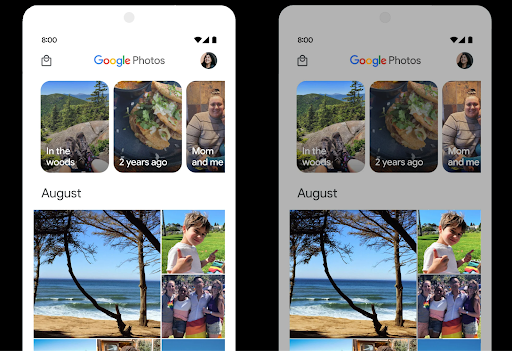
Controllo del loudness

Android 15 introduces support for the CTA-2075 loudness standard to help you avoid audio loudness inconsistencies and ensure users don't have to constantly adjust volume when switching between content. The system leverages known characteristics of the output devices (headphones and speaker) along with loudness metadata available in AAC audio content to intelligently adjust the audio loudness and dynamic range compression levels.
To enable this feature, you need to ensure loudness metadata is available in
your AAC content and enable the platform feature in your app. For this, you
instantiate a LoudnessCodecController object by
calling its create factory method with the audio
session ID from the associated AudioTrack; this
automatically starts applying audio updates. You can pass an
OnLoudnessCodecUpdateListener to modify or filter
loudness parameters before they are applied on the
MediaCodec.
// Media contains metadata of type MPEG_4 OR MPEG_D
val mediaCodec = …
val audioTrack = AudioTrack.Builder()
.setSessionId(sessionId)
.build()
...
// Create new loudness controller that applies the parameters to the MediaCodec
try {
val lcController = LoudnessCodecController.create(mSessionId)
// Starts applying audio updates for each added MediaCodec
}
AndroidX media3 ExoPlayer will also be updated to use the
LoudnessCodecController APIs for a seamless app integration.
Dispositivi MIDI virtuali 2.0
Android 13 added support for connecting to MIDI 2.0 devices using USB, which communicate using Universal MIDI Packets (UMP). Android 15 extends UMP support to virtual MIDI apps, enabling composition apps to control synthesizer apps as a virtual MIDI 2.0 device just like they would with an USB MIDI 2.0 device.
Decodifica software AV1 più efficiente

dav1d, il popolare decodificatore software AV1 di VideoLAN, è disponibile per i dispositivi Android che non supportano la decodifica AV1 in hardware. dav1d è fino a 3 volte più performante del precedente decodificatore software AV1, il che consente la riproduzione di AV1 HD a un maggior numero di utenti, inclusi alcuni dispositivi di fascia bassa e media.
La tua app deve attivare l'utilizzo di dav1d invocandolo per nome"c2.android.av1-dav1d.decoder". In un aggiornamento successivo, dav1d diventerà il decodificatore software AV1 predefinito. Questo supporto è standardizzato e sottoposto a backporting sui dispositivi Android 11 che ricevono gli aggiornamenti di sistema di Google Play.
Produttività e strumenti per gli sviluppatori
La maggior parte del nostro lavoro per migliorare la tua produttività si concentra su strumenti come Android Studio, Jetpack Compose e le librerie Android Jetpack, ma cerchiamo sempre modi nella piattaforma per aiutarti a realizzare più facilmente la tua visione.
Aggiornamenti di OpenJDK 17
Android 15 continues the work of refreshing Android's core libraries to align with the features in the latest OpenJDK LTS releases.
The following key features and improvements are included:
- Quality-of-life improvements around NIO buffers
- Streams
- Additional
mathandstrictmathmethods utilpackage updates including sequencedcollection,map, andsetByteBuffersupport inDeflater- Security updates such as
X500PrivateCredentialand security key updates
These APIs are updated on over a billion devices running Android 12 (API level 31) and higher through Google Play System updates, so you can target the latest programming features.
Miglioramenti al PDF
Android 15 includes substantial improvements to the PdfRenderer
APIs. Apps can incorporate advanced features such as rendering
password-protected files, annotations, form editing,
searching, and selection with copy. Linearized PDF
optimizations are supported to speed local PDF viewing and reduce resource use.
The Jetpack PDF library uses these APIs to simplify adding PDF
viewing capabilities to your app.

The PdfRenderer has been moved to a module that can be updated using Google
Play system updates independent of the platform release, and we're supporting
these changes back to Android 11 (API level 30) by creating a compatible
pre-Android 15 version of the API surface, called
PdfRendererPreV.
Perfezionamenti del cambio di lingua automatico
Android 14 added on-device, multi-language recognition in audio with automatic
switching between languages, but this can cause words to get dropped,
especially when languages switch with less of a pause between the two
utterances. Android 15 adds additional controls to help apps tune this switching
to their use case.
EXTRA_LANGUAGE_SWITCH_INITIAL_ACTIVE_DURATION_TIME_MILLIS
confines the automatic switching to the beginning of the audio session, while
EXTRA_LANGUAGE_SWITCH_MATCH_SWITCHES deactivates the
language switching after a defined number of switches. These options are
particularly useful if you expect that there will be a single language spoken
during the session that should be autodetected.
API per caratteri variabili OpenType migliorata
Android 15 improves the usability of the OpenType variable font. You can create
a FontFamily instance from a variable font without specifying weight axes
with the buildVariableFamily API. The text renderer overrides the value
of wght axis to match the displaying text.
Using the API simplifies the code for creating a Typeface considerably:
Kotlin
val newTypeface = Typeface.CustomFallbackBuilder( FontFamily.Builder( Font.Builder(assets, "RobotoFlex.ttf").build()) .buildVariableFamily()) .build()
Java
Typeface newTypeface = Typeface.CustomFallbackBuilder( new FontFamily.Builder( new Font.Builder(assets, "RobotoFlex.ttf").build()) .buildVariableFamily()) .build();
Previously, to create the same Typeface, you would need much more code:
Kotlin
val oldTypeface = Typeface.CustomFallbackBuilder( FontFamily.Builder( Font.Builder(assets, "RobotoFlex.ttf") .setFontVariationSettings("'wght' 400") .setWeight(400) .build()) .addFont( Font.Builder(assets, "RobotoFlex.ttf") .setFontVariationSettings("'wght' 100") .setWeight(100) .build() ) .addFont( Font.Builder(assets, "RobotoFlex.ttf") .setFontVariationSettings("'wght' 200") .setWeight(200) .build() ) .addFont( Font.Builder(assets, "RobotoFlex.ttf") .setFontVariationSettings("'wght' 300") .setWeight(300) .build() ) .addFont( Font.Builder(assets, "RobotoFlex.ttf") .setFontVariationSettings("'wght' 500") .setWeight(500) .build() ) .addFont( Font.Builder(assets, "RobotoFlex.ttf") .setFontVariationSettings("'wght' 600") .setWeight(600) .build() ) .addFont( Font.Builder(assets, "RobotoFlex.ttf") .setFontVariationSettings("'wght' 700") .setWeight(700) .build() ) .addFont( Font.Builder(assets, "RobotoFlex.ttf") .setFontVariationSettings("'wght' 800") .setWeight(800) .build() ) .addFont( Font.Builder(assets, "RobotoFlex.ttf") .setFontVariationSettings("'wght' 900") .setWeight(900) .build() ).build() ).build()
Java
Typeface oldTypeface = new Typeface.CustomFallbackBuilder( new FontFamily.Builder( new Font.Builder(assets, "RobotoFlex.ttf") .setFontVariationSettings("'wght' 400") .setWeight(400) .build() ) .addFont( new Font.Builder(assets, "RobotoFlex.ttf") .setFontVariationSettings("'wght' 100") .setWeight(100) .build() ) .addFont( new Font.Builder(assets, "RobotoFlex.ttf") .setFontVariationSettings("'wght' 200") .setWeight(200) .build() ) .addFont( new Font.Builder(assets, "RobotoFlex.ttf") .setFontVariationSettings("'wght' 300") .setWeight(300) .build() ) .addFont( new Font.Builder(assets, "RobotoFlex.ttf") .setFontVariationSettings("'wght' 500") .setWeight(500) .build() ) .addFont( new Font.Builder(assets, "RobotoFlex.ttf") .setFontVariationSettings("'wght' 600") .setWeight(600) .build() ) .addFont( new Font.Builder(assets, "RobotoFlex.ttf") .setFontVariationSettings("'wght' 700") .setWeight(700) .build() ) .addFont( new Font.Builder(assets, "RobotoFlex.ttf") .setFontVariationSettings("'wght' 800") .setWeight(800) .build() ) .addFont( new Font.Builder(assets, "RobotoFlex.ttf") .setFontVariationSettings("'wght' 900") .setWeight(900) .build() ) .build() ).build();
Here's an example of how a Typeface created with both the old and new APIs
renders:
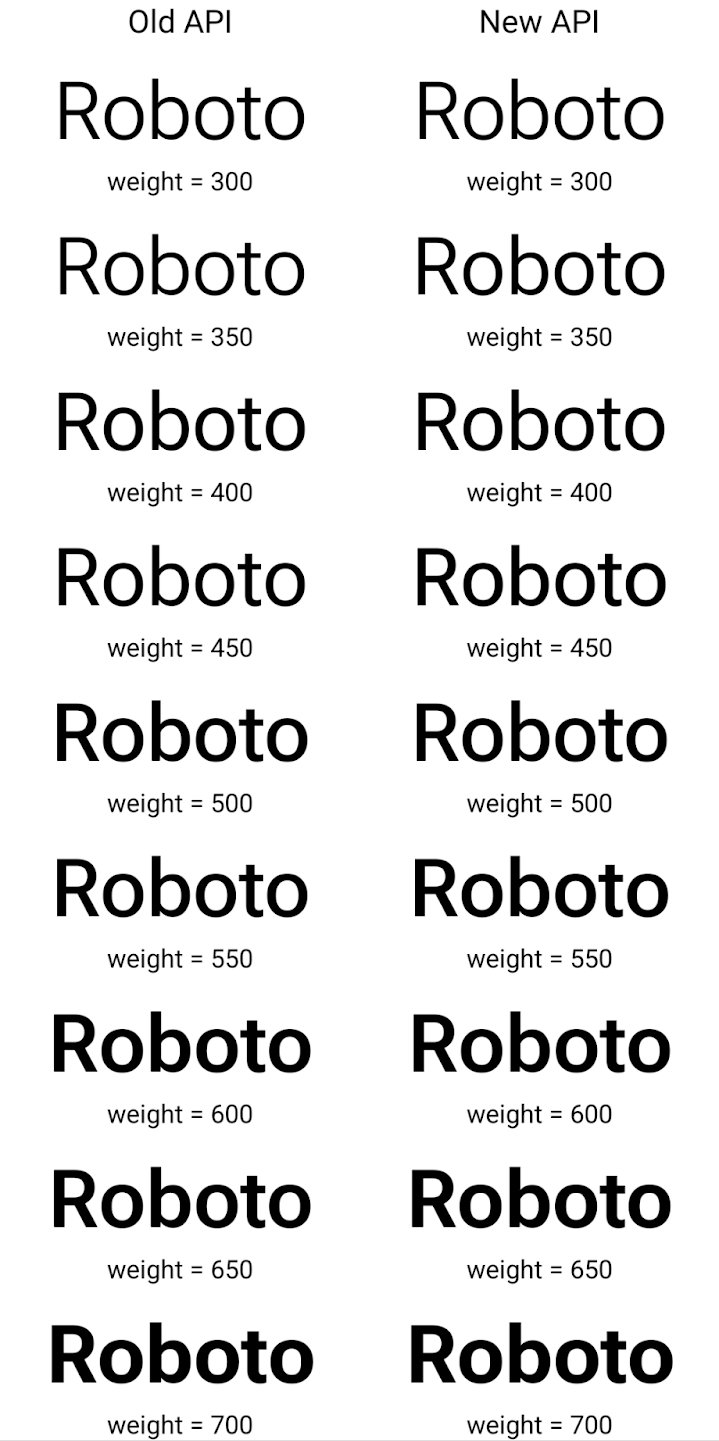
In this example, the Typeface created with the old API doesn't have the
capability to create accurate font weights for the 350, 450, 550 and 650
Font instances, so the renderer falls back to the closest weight. So in
this case, 300 is rendered instead of 350, 400 is rendered instead of 450, and
so on. By contrast, the Typeface created with the new APIs dynamically creates
a Font instance for a given weight, so accurate weights are rendered for 350,
450, 550, and 650 as well.
Controlli granulari delle interruzioni di riga
A partire da Android 15, un TextView e l'interruzione di riga sottostante possono conservare la parte di testo specificata nella stessa riga per migliorare la leggibilità. Puoi sfruttare questa personalizzazione dell'interruzione di riga utilizzando il tag <nobreak> nelle risorse stringa o createNoBreakSpan. Analogamente, puoi impedire la suddivisione delle parole in sillabe utilizzando il tag <nohyphen> o createNoHyphenationSpan.
Ad esempio, la seguente risorsa stringa non include un a capo e viene visualizzata con il testo "Pixel 8 Pro" interrotto in un punto indesiderato:
<resources>
<string name="pixel8pro">The power and brains behind Pixel 8 Pro.</string>
</resources>
Al contrario, questa risorsa stringa include il tag <nobreak>, che inserisce un a capo nella frase "Pixel 8 Pro" e impedisce gli a capo:
<resources>
<string name="pixel8pro">The power and brains behind <nobreak>Pixel 8 Pro.</nobreak></string>
</resources>
La differenza nel modo in cui queste stringhe vengono visualizzate è mostrata nelle seguenti immagini:
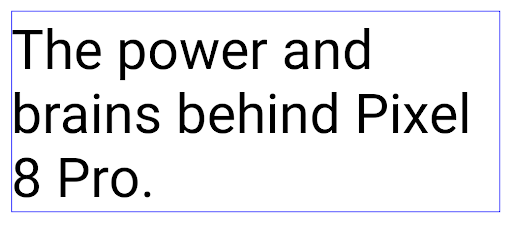
<nobreak>.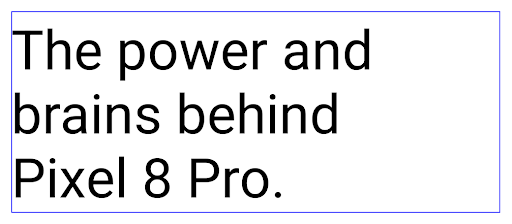
<nobreak>.Archiviazione delle app
Android and Google Play announced support for app archiving last year, allowing users to free up space by partially removing infrequently used apps from the device that were published using Android App Bundle on Google Play. Android 15 includes OS level support for app archiving and unarchiving, making it easier for all app stores to implement it.
Apps with the REQUEST_DELETE_PACKAGES permission can call the
PackageInstaller requestArchive method to request archiving an
installed app package, which removes the APK and any cached files, but persists
user data. Archived apps are returned as displayable apps through the
LauncherApps APIs; users will see a UI treatment to highlight that those
apps are archived. If a user taps on an archived app, the responsible installer
will get a request to unarchive it, and the restoration process can be
monitored by the ACTION_PACKAGE_ADDED broadcast.
Enable 16 KB mode on a device using developer options
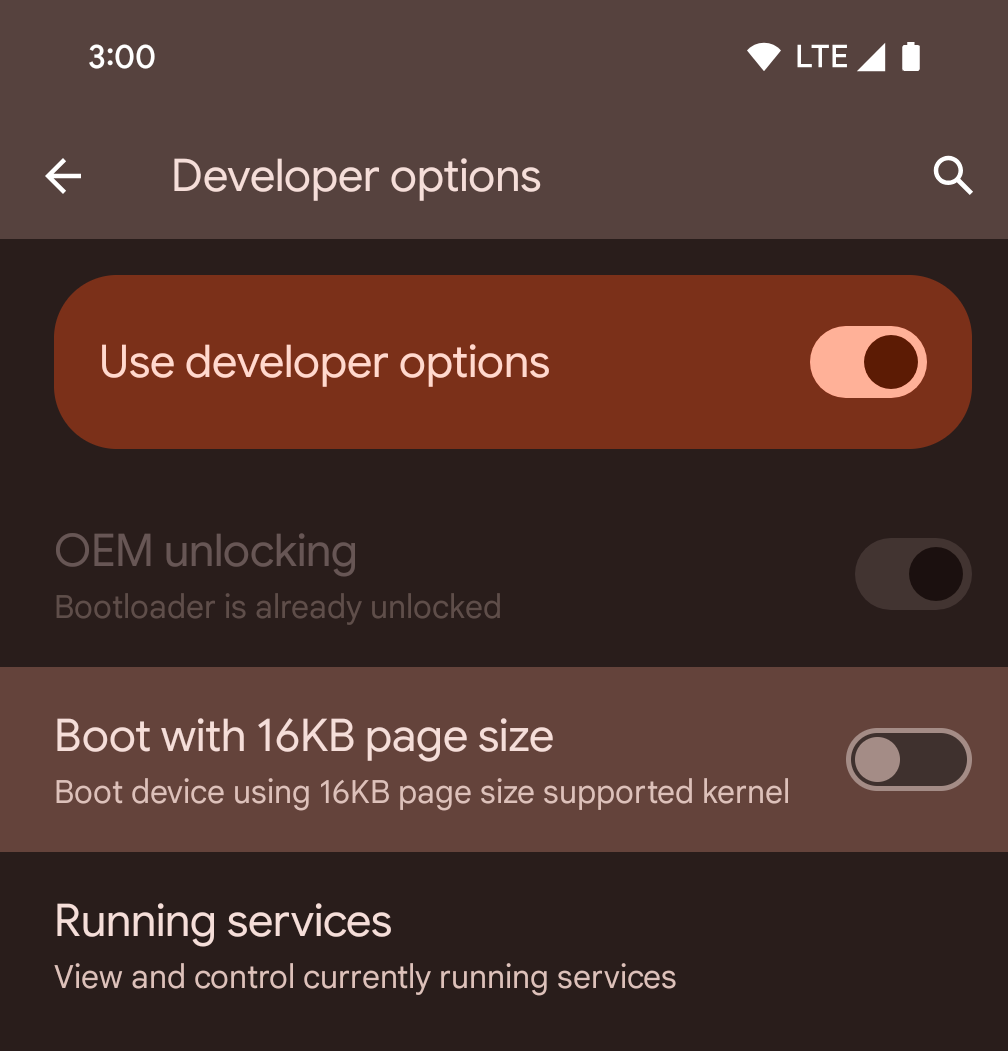
Toggle the Boot with 16KB page size developer option to boot a device in 16 KB mode.
Starting with Android 15 QPR1, you can use the developer option that's available on certain devices to boot the device in 16 KB mode and perform on-device testing. Before using the developer option, go to Settings > System > Software updates and apply any updates that are available.
This developer option is available on the following devices:
Pixel 8 and 8 Pro (with Android 15 QPR1 or higher)
Pixel 8a (with Android 15 QPR1 or higher)
Pixel 9, 9 Pro, and 9 Pro XL (with Android 15 QPR2 Beta 2 or higher)
Grafica
Android 15 offre i più recenti miglioramenti grafici, tra cui ANGLE e aggiunte al sistema grafico Canvas.
Modernizzazione dell'accesso alla GPU di Android

Android hardware has evolved quite a bit from the early days where the core OS would run on a single CPU and GPUs were accessed using APIs based on fixed-function pipelines. The Vulkan® graphics API has been available in the NDK since Android 7.0 (API level 24) with a lower-level abstraction that better reflects modern GPU hardware, scales better to support multiple CPU cores, and offers reduced CPU driver overhead — leading to improved app performance. Vulkan is supported by all modern game engines.
Vulkan is Android's preferred interface to the GPU. Therefore, Android 15 includes ANGLE as an optional layer for running OpenGL® ES on top of Vulkan. Moving to ANGLE will standardize the Android OpenGL implementation for improved compatibility, and, in some cases, improved performance. You can test out your OpenGL ES app stability and performance with ANGLE by enabling the developer option in Settings -> System -> Developer Options -> Experimental: Enable ANGLE on Android 15.
The Android ANGLE on Vulkan roadmap

As part of streamlining our GPU stack, going forward we will be shipping ANGLE as the GL system driver on more new devices, with the future expectation that OpenGL/ES will be only available through ANGLE. That being said, we plan to continue support for OpenGL ES on all devices.
Recommended next steps
Use the developer options to select the ANGLE driver for OpenGL ES and test your app. For new projects, we strongly encourage using Vulkan for C/C++.
Miglioramenti per Canvas
Android 15 continua la nostra modernizzazione del sistema grafico Canvas di Android con funzionalità aggiuntive:
Matrix44fornisce una matrice 4x4 per la trasformazione delle coordinate da utilizzare quando vuoi manipolare la tela in 3D.clipShaderinterseca il clip corrente con lo shader specificato, mentreclipOutShaderimposta il clip sulla differenza tra il clip corrente e lo shader, trattando ciascuno lo shader come una maschera alfa. Ciò consente di disegnare in modo efficiente forme complesse.
Prestazioni e batteria
Android continua a concentrarsi sull'aiutarti a migliorare il rendimento e la qualità delle tue app. Android 15 introduce API che contribuiscono a rendere più efficienti le attività nella tua app, a ottimizzare le prestazioni dell'app e a raccogliere approfondimenti sulle tue app.
Per le best practice per l'efficienza della batteria, il debug dell'utilizzo di rete ed energia e dettagli su come stiamo migliorando l'efficienza della batteria del lavoro in background in Android 15 e nelle versioni recenti di Android, guarda il talk Migliorare l'efficienza della batteria del lavoro in background su Android di Google I/O.
API ApplicationStartInfo
In previous versions of Android, app startup has been a bit of a mystery. It was
challenging to determine within your app whether it started from a cold, warm,
or hot state. It was also difficult to know how long your app spent during the
various launch phases: forking the process, calling onCreate, drawing the
first frame, and more. When your Application class was instantiated, you had no
way of knowing whether the app started from a broadcast, a content provider, a
job, a backup, boot complete, an alarm, or an Activity.
The ApplicationStartInfo API on Android 15 provides
all of this and more. You can even choose to add your own timestamps into the
flow to help collect timing data in one place. In addition to collecting
metrics, you can use ApplicationStartInfo to help directly optimize app
startup; for example, you can eliminate the costly instantiation of UI-related
libraries within your Application class when your app is starting up due to a
broadcast.
Informazioni dettagliate sulle dimensioni dell'app
Since Android 8.0 (API level 26), Android has included the
StorageStats.getAppBytes API that summarizes the installed
size of an app as a single number of bytes, which is a sum of the APK size, the
size of files extracted from the APK, and files that were generated on the
device such as ahead-of-time (AOT) compiled code. This number is not very
insightful in terms of how your app is using storage.
Android 15 adds the
StorageStats.getAppBytesByDataType([type]) API, which lets
you get insight into how your app is using up all that space, including APK file
splits, AOT and speedup related code, dex metadata, libraries, and guided
profiles.
Profilazione gestita dalle app
Android 15 includes the ProfilingManager class,
which lets you collect profiling information from within your app such as heap
dumps, heap profiles, stack sampling, and more. It provides a callback to your
app with a supplied tag to identify the output file, which is delivered to your
app's files directory. The API does rate limiting to minimize the performance
impact.
To simplify constructing profiling requests in your app, we recommend using the
corresponding Profiling AndroidX API, available
in Core 1.15.0-rc01 or higher.
Miglioramenti al database SQLite
Android 15 introduces SQLite APIs that expose advanced features from the underlying SQLite engine that target specific performance issues that can manifest in apps. These APIs are included with the update of SQLite to version 3.44.3.
Developers should consult best practices for SQLite performance to get the most out of their SQLite database, especially when working with large databases or when running latency-sensitive queries.
- Read-only deferred transactions: when issuing transactions that are
read-only (don't include write statements), use
beginTransactionReadOnly()andbeginTransactionWithListenerReadOnly(SQLiteTransactionListener)to issue read-onlyDEFERREDtransactions. Such transactions can run concurrently with each other, and if the database is in WAL mode, they can run concurrently withIMMEDIATEorEXCLUSIVEtransactions. - Row counts and IDs: APIs were added to retrieve the count of changed
rows or the last inserted row ID without issuing an additional query.
getLastChangedRowCount()returns the number of rows that were inserted, updated, or deleted by the most recent SQL statement within the current transaction, whilegetTotalChangedRowCount()returns the count on the current connection.getLastInsertRowId()returns therowidof the last row to be inserted on the current connection. - Raw statements: issue a raw SQlite statement, bypassing convenience wrappers and any additional processing overhead that they may incur.
Aggiornamenti di Android Dynamic Performance Framework
Android 15 continua il nostro investimento nell'Android Dynamic Performance Framework (ADPF), un insieme di API che consente a giochi e app ad alte prestazioni di interagire più direttamente con i sistemi di alimentazione e termici dei dispositivi Android. Sui dispositivi supportati, Android 15 aggiunge le funzionalità ADPF:
- Una modalità di risparmio energetico per le sessioni di suggerimenti per indicare che i thread associati devono dare la priorità al risparmio energetico rispetto alle prestazioni, ideale per i carichi di lavoro in background di lunga durata.
- Le durate del lavoro della GPU e della CPU possono essere entrambe registrate nelle sessioni di suggerimenti, consentendo al sistema di regolare le frequenze della CPU e della GPU insieme per soddisfare al meglio le richieste del carico di lavoro.
- Soglie di headroom termico per interpretare il possibile stato di throttling termico in base alla previsione dell'headroom.
Per scoprire di più su come utilizzare ADPF nelle tue app e nei tuoi giochi, consulta la documentazione.
Privacy
Android 15 include una serie di funzionalità che aiutano gli sviluppatori di app a proteggere la privacy degli utenti.
Rilevamento della registrazione dello schermo
Android 15 aggiunge il supporto delle app per rilevare che vengono registrate. Un callback viene invocato ogni volta che l'app passa da visibile a invisibile all'interno di una registrazione dello schermo. Un'app è considerata visibile se vengono registrate attività di proprietà dell'UID della procedura di registrazione. In questo modo, se la tua app esegue un'operazione sensibile, puoi informare l'utente che è in corso una registrazione.
val mCallback = Consumer<Int> { state ->
if (state == SCREEN_RECORDING_STATE_VISIBLE) {
// We're being recorded
} else {
// We're not being recorded
}
}
override fun onStart() {
super.onStart()
val initialState =
windowManager.addScreenRecordingCallback(mainExecutor, mCallback)
mCallback.accept(initialState)
}
override fun onStop() {
super.onStop()
windowManager.removeScreenRecordingCallback(mCallback)
}
Funzionalità IntentFilter ampliate
Android 15 supporta la risoluzione Intent più precisa tramite
UriRelativeFilterGroup, che contiene un insieme di
UriRelativeFilter oggetti che formano un insieme di Intent
regole di corrispondenza che devono essere soddisfatte, inclusi i parametri di query dell'URL, i frammenti di URL e le regole di blocco o esclusione.
Queste regole possono essere definite nel file XML AndroidManifest con il
tag <uri-relative-filter-group>, che può includere facoltativamente un
tag android:allow. Questi tag possono contenere tag <data> che utilizzano attributi di tag dati esistenti,
nonché gli attributi android:query e android:fragment.
Ecco un esempio di sintassi di AndroidManifest:
<intent-filter android:autoVerify="true">
<action android:name="android.intent.action.VIEW" />
<category android:name="android.intent.category.BROWSABLE" />
<category android:name="android.intent.category.DEFAULT" />
<data android:scheme="http" />
<data android:scheme="https" />
<data android:host="astore.com" />
<uri-relative-filter-group>
<data android:pathPrefix="/auth" />
<data android:query="region=na" />
</uri-relative-filter-group>
<uri-relative-filter-group android:allow="false">
<data android:pathPrefix="/auth" />
<data android:query="mobileoptout=true" />
</uri-relative-filter-group>
<uri-relative-filter-group android:allow="false">
<data android:pathPrefix="/auth" />
<data android:fragmentPrefix="faq" />
</uri-relative-filter-group>
</intent-filter>
Spazio privato
Private space lets users create a separate space on their device where they can keep sensitive apps away from prying eyes, under an additional layer of authentication. The private space uses a separate user profile. The user can choose to use the device lock or a separate lock factor for the private space.
Apps in the private space show up in a separate container in the launcher, and are hidden from the recents view, notifications, settings, and from other apps when the private space is locked. User-generated and downloaded content (such as media or files) and accounts are separated between the private space and the main space. The system sharesheet and the photo picker can be used to give apps access to content across spaces when the private space is unlocked.
Users can't move existing apps and their data into the private space. Instead, users select an install option in the private space to install an app using whichever app store they prefer. Apps in the private space are installed as separate copies from any apps in the main space (new copies of the same app).
When a user locks the private space, the profile is stopped. While the profile is stopped, apps in the private space are no longer active and can't perform foreground or background activities, including showing notifications.
We recommend that you test your app with private space to make sure your app works as expected, especially if your app falls into one of the following categories:
- Apps with logic for work profiles that assumes that any installed copies of their app that aren't in the main profile are in the work profile.
- Medical apps
- Launcher apps
- App store apps
Eseguire query sulla selezione più recente dell'utente per l'accesso alle foto selezionate
Apps can now highlight only the most-recently-selected photos and videos when
partial access to media permissions is granted. This feature can improve
the user experience for apps that frequently request access to photos and
videos. To use this feature in your app, enable the
QUERY_ARG_LATEST_SELECTION_ONLY argument when querying MediaStore
through ContentResolver.
Kotlin
val externalContentUri = MediaStore.Files.getContentUri("external") val mediaColumns = arrayOf( FileColumns._ID, FileColumns.DISPLAY_NAME, FileColumns.MIME_TYPE, ) val queryArgs = bundleOf( // Return only items from the last selection (selected photos access) QUERY_ARG_LATEST_SELECTION_ONLY to true, // Sort returned items chronologically based on when they were added to the device's storage QUERY_ARG_SQL_SORT_ORDER to "${FileColumns.DATE_ADDED} DESC", QUERY_ARG_SQL_SELECTION to "${FileColumns.MEDIA_TYPE} = ? OR ${FileColumns.MEDIA_TYPE} = ?", QUERY_ARG_SQL_SELECTION_ARGS to arrayOf( FileColumns.MEDIA_TYPE_IMAGE.toString(), FileColumns.MEDIA_TYPE_VIDEO.toString() ) )
Java
Uri externalContentUri = MediaStore.Files.getContentUri("external"); String[] mediaColumns = { FileColumns._ID, FileColumns.DISPLAY_NAME, FileColumns.MIME_TYPE }; Bundle queryArgs = new Bundle(); queryArgs.putBoolean(MediaStore.QUERY_ARG_LATEST_SELECTION_ONLY, true); queryArgs.putString(MediaStore.QUERY_ARG_SQL_SORT_ORDER, FileColumns.DATE_ADDED + " DESC"); queryArgs.putString(MediaStore.QUERY_ARG_SQL_SELECTION, FileColumns.MEDIA_TYPE + " = ? OR " + FileColumns.MEDIA_TYPE + " = ?"); queryArgs.putStringArray(MediaStore.QUERY_ARG_SQL_SELECTION_ARGS, new String[] { String.valueOf(FileColumns.MEDIA_TYPE_IMAGE), String.valueOf(FileColumns.MEDIA_TYPE_VIDEO) });
Privacy Sandbox su Android
Android 15 includes the latest Android Ad Services extensions, incorporating the latest version of the Privacy Sandbox on Android. This addition is part of our work to develop technologies that improve user privacy and enable effective, personalized advertising experiences for mobile apps. Our privacy sandbox page has more information about the Privacy Sandbox on Android developer preview and beta programs to help you get started.
Connessione Salute
Android 15 integra le ultime estensioni Connessione Salute di Android, un servizio sicuro e centralizzato per gestire e condividere i dati relativi a salute e fitness raccolti da app. Questo aggiornamento aggiunge il supporto per tipi di dati aggiuntivi in fitness, alimentazione, temperatura cutanea, piani di allenamento e altro ancora.
Il monitoraggio della temperatura cutanea consente agli utenti di memorizzare e condividere dati sulla temperatura più precisi da un dispositivo indossabile o da un altro dispositivo di monitoraggio.
I piani di allenamento sono programmi di allenamento strutturati per aiutare un utente a raggiungere i suoi obiettivi di fitness. Il supporto dei piani di allenamento include una serie di obiettivi di completamento e rendimento:
- Obiettivi di completamento relativi a calorie bruciate, distanza, durata, ripetizioni e passi.
- Obiettivi di rendimento relativi a il maggior numero possibile di ripetizioni (AMRAP), frequenza, battito cardiaco, alimentazione, tasso di sforzo percepito e velocità.
Scopri di più sugli ultimi aggiornamenti di Connessione Salute su Android nel Creare esperienze adattabili con Android Discussione sulla salute di Google I/O.
Condivisione della schermata dell'app
Android 15 supporta la condivisione dello schermo delle app, quindi gli utenti possono condividere o registrare solo una finestra dell'app anziché l'intero schermo del dispositivo. Questa funzionalità, attivata per la prima volta in Android 14 QPR2, include callback di MediaProjection che consentono alla tua app di personalizzare l'esperienza di condivisione schermo dell'app. Tieni presente che per le app che hanno come target Android 14 (livello API 34) o versioni successive, il consenso dell'utente è obbligatorio per ogni sessione di acquisizione MediaProjection.
Esperienza utente e UI di sistema
Android 15 offre agli sviluppatori di app e agli utenti maggiore controllo e flessibilità per configurare il dispositivo in base alle proprie esigenze.
Per scoprire di più su come utilizzare i miglioramenti più recenti di Android 15 per migliorare l'esperienza utente della tua app, guarda la presentazione Migliorare l'esperienza utente della tua app Android di Google I/O.
Anteprime dei widget più ricche con l'API Generated Previews
Prima di Android 15, l'unico modo per fornire anteprime del selettore widget era specificare una risorsa immagine o layout statica. Queste anteprime spesso sono diverse molto dall'aspetto del widget reale quando è posizionato sulla home page schermo. Inoltre, non è possibile creare risorse statiche con Jetpack Glance, quindi Riepilogo uno sviluppatore ha dovuto fare uno screenshot del widget o creare un layout XML l'anteprima del widget.
Android 15 aggiunge il supporto per le anteprime generate. Ciò significa che il widget dell'app
i provider possono generare RemoteViews da usare come anteprima del selettore,
di una risorsa statica.
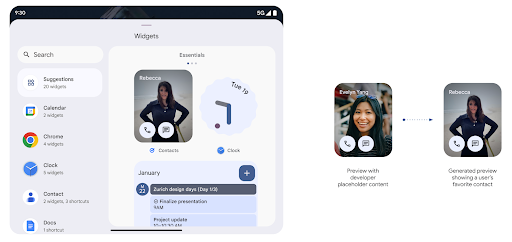
API Push
Le app possono fornire anteprime generate tramite un'API push. Le app possono fornire anteprime in qualsiasi momento del loro ciclo di vita e non ricevono una richiesta esplicita dall'host per fornire anteprime. Le anteprime vengono conservate in AppWidgetService e gli autori possono richiederle on demand. L'esempio seguente carica una risorsa di layout del widget XML e la imposta come anteprima:
AppWidgetManager.getInstance(appContext).setWidgetPreview(
ComponentName(
appContext,
SociaLiteAppWidgetReceiver::class.java
),
AppWidgetProviderInfo.WIDGET_CATEGORY_HOME_SCREEN,
RemoteViews("com.example", R.layout.widget_preview)
)
Il flusso previsto è:
- In qualsiasi momento, il fornitore del widget chiama
setWidgetPreview. Le anteprime fornite vengono conservate inAppWidgetServiceinsieme ad altre informazioni del fornitore. setWidgetPreviewinvia una notifica agli host di un'anteprima aggiornata tramite il callbackAppWidgetHost.onProvidersChanged. In risposta, l'host del widget ricarica tutte le informazioni del fornitore.- Quando viene visualizzata un'anteprima del widget, l'host controlla
AppWidgetProviderInfo.generatedPreviewCategoriese, se la categoria scelta è disponibile, chiamaAppWidgetManager.getWidgetPreviewper restituire l'anteprima salvata per questo fornitore.
Quando chiamare setWidgetPreview
Poiché non è necessario richiamare le anteprime, le app possono scegliere di inviare vengono visualizzate in qualsiasi momento quando sono in esecuzione. La frequenza con cui aggiornare l'anteprima dipende dal caso d'uso del widget.
L'elenco seguente descrive le due categorie principali di casi d'uso di anteprima:
- Fornitori che mostrano dati reali nelle anteprime dei widget, ad esempio informazioni personalizzate o recenti. Questi fornitori possono impostare l'anteprima dopo che l'utente ha eseguito l'accesso o ha completato la configurazione iniziale nella propria app. Dopodiché, possono configurare un'attività periodica per aggiornare le anteprime con la cadenza scelta. Esempi di questo tipo di widget possono essere foto, calendario, meteo o notizie.
- Fornitori che mostrano informazioni statiche nelle anteprime o nei widget di azioni rapide che non mostrano dati. Questi fornitori possono impostare le anteprime una sola volta, quando viene avviata per la prima volta. Alcuni esempi di questo tipo di widget includono una guida rapida widget azioni o widget scorciatoie di Chrome.
Alcuni fornitori potrebbero mostrare anteprime statiche nel selettore della modalità Hub, ma informazioni reali nel selettore della schermata Home. Questi fornitori devono seguire le indicazioni per entrambi i casi d'uso per impostare le anteprime.
Picture in picture
Android 15 introduces changes in Picture-in-Picture (PiP) ensuring an even smoother transition when entering into PiP mode. This will be beneficial for apps having UI elements overlaid on top of their main UI, which goes into PiP.
Developers use the onPictureInPictureModeChanged callback to define logic
that toggles the visibility of the overlaid UI elements. This callback is
triggered when the PiP enter or exit animation is completed. Beginning in
Android 15, the PictureInPictureUiState class includes another state.
With this UI state, apps targeting Android 15 (API level 35) will observe the
Activity#onPictureInPictureUiStateChanged callback being invoked with
isTransitioningToPip() as soon as the PiP animation starts. There are
many UI elements that are not relevant for the app when it is in PiP mode, for
example views or layout that include information such as suggestions, upcoming
video, ratings, and titles. When the app goes to PiP mode, use the
onPictureInPictureUiStateChanged callback to hide these UI elements. When the
app goes to full screen mode from the PiP window, use
onPictureInPictureModeChanged callback to unhide these elements, as shown in
the following examples:
override fun onPictureInPictureUiStateChanged(pipState: PictureInPictureUiState) {
if (pipState.isTransitioningToPip()) {
// Hide UI elements
}
}
override fun onPictureInPictureModeChanged(isInPictureInPictureMode: Boolean) {
if (isInPictureInPictureMode) {
// Unhide UI elements
}
}
This quick visibility toggle of irrelevant UI elements (for a PiP window) helps ensure a smoother and flicker-free PiP enter animation.
Regole Non disturbare migliorate
AutomaticZenRule consente alle app di personalizzare la funzionalità Attenzione
Gestione delle regole (Non disturbare) e decidere quando attivarle o disattivarle
che li rappresentano. Android 15 migliora notevolmente queste regole con l'obiettivo di migliorare
un'esperienza utente positiva. Sono inclusi i seguenti miglioramenti:
- Aggiunta di tipi a
AutomaticZenRule, in modo che il sistema possa applicare tipi per alcune regole. - L'aggiunta di un'icona a
AutomaticZenRule, che contribuisce a rendere le modalità più riconoscibili. - Aggiunta a
AutomaticZenRuledi una stringatriggerDescriptionche descriva le condizioni in cui la regola deve diventare attiva per l'utente. - Aggiunta
ZenDeviceEffectsaAutomaticZenRule, consentendo alle regole di attivare elementi come scala di grigi schermo, modalità notturna o attenuazione dello sfondo.
Impostare VibrationEffect per i canali di notifica
Android 15 supports setting rich vibrations for incoming notifications by
channel using NotificationChannel.setVibrationEffect, so
your users can distinguish between different types of notifications without
having to look at their device.
Etichetta della barra di stato della proiezione di contenuti multimediali e arresto automatico
La proiezione di contenuti multimediali può esporre informazioni private degli utenti. Un nuovo chip della barra di stato in evidenza informa gli utenti di eventuali proiezioni dello schermo in corso. Gli utenti possono toccare il chip per interrompere la trasmissione, la condivisione o la registrazione dello schermo. Inoltre, per un'esperienza utente più intuitiva, qualsiasi proiezione dello schermo in corso ora si interrompe automaticamente quando lo schermo del dispositivo è bloccato.

Schermi grandi e fattori di forma
Android 15 offre alle tue app il supporto per sfruttare al meglio i fattori di forma di Android, inclusi schermi di grandi dimensioni, smartphone con apertura a libro e pieghevoli.
Multitasking migliore su schermo grande
Android 15 gives users better ways to multitask on large screen devices. For example, users can save their favorite split-screen app combinations for quick access and pin the taskbar on screen to quickly switch between apps. This means that making sure your app is adaptive is more important than ever.
Google I/O has sessions on Building adaptive Android apps and Building UI with the Material 3 adaptive library that can help, and our documentation has more to help you Design for large screens.
Supporto dello schermo della cover
La tua app può dichiarare una proprietà utilizzata da Android 15 per consentire la visualizzazione di Application o Activity sulle piccole schermate di copertina dei dispositivi pieghevoli supportati. Questi schermi sono troppo piccoli per essere considerati come target compatibili per l'esecuzione delle app per Android, ma la tua app può attivare il loro supporto, rendendola disponibile in più luoghi.
Connettività
Android 15 aggiorna la piattaforma per consentire alla tua app di accedere agli ultimi progressi nelle tecnologie di comunicazione e wireless.
Supporto satellitare
Android 15 continues to extend platform support for satellite connectivity and includes some UI elements to ensure a consistent user experience across the satellite connectivity landscape.
Apps can use ServiceState.isUsingNonTerrestrialNetwork() to
detect when a device is connected to a satellite, giving them more awareness of
why full network services might be unavailable. Additionally, Android 15
provides support for SMS and MMS apps as well as preloaded RCS apps to use
satellite connectivity for sending and receiving messages.
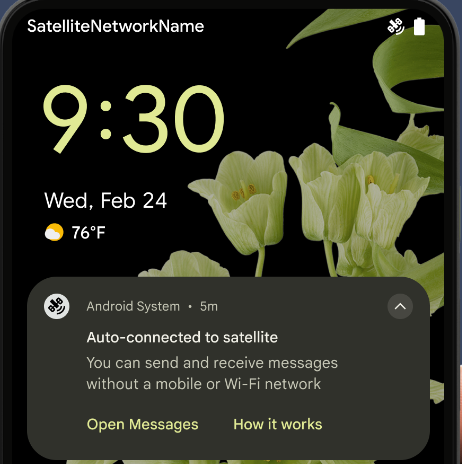
Esperienze NFC più fluide
Android 15 is working to make the tap to pay experience more seamless and
reliable while continuing to support Android's robust NFC app ecosystem. On
supported devices, apps can request the NfcAdapter to enter
observe mode, where the device listens but doesn't respond to NFC
readers, sending the app's NFC service PollingFrame
objects to process. The PollingFrame objects can be used to auth
ahead of the first communication to the NFC reader, allowing for a one tap
transaction in many cases.
In addition, apps can register a filter on supported devices so they can be notified of polling loop activity, which allows for smooth operation with multiple NFC-aware applications.
Ruolo del wallet
Android 15 introduces a Wallet role that allows tighter integration with the user's preferred wallet app. This role replaces the NFC default contactless payment setting. Users can manage the Wallet role holder by navigating to Settings > Apps > Default Apps.
The Wallet role is used when routing NFC taps for AIDs registered in the payment category. Taps always go to the Wallet role holder unless another app that is registered for the same AID is running in the foreground.
This role is also used to determine where the Wallet Quick Access tile should go when activated. When the role is set to "None", the Quick Access tile isn't available and payment category NFC taps are only delivered to the foreground app.
Sicurezza
Android 15 ti aiuta a migliorare la sicurezza della tua app, proteggere i dati dell'app e offre agli utenti maggiore trasparenza e controllo sui propri dati. Guarda il talk Safeguarding user security on Android di Google I/O per scoprire di più su cosa stiamo facendo per migliorare le misure di salvaguardia degli utenti e proteggere la tua app da nuove minacce.
Integrare Gestore delle credenziali con la compilazione automatica
Starting with Android 15, developers can link specific views like username or password fields with Credential Manager requests, making it easier to provide a tailored user experience during the sign-in process. When the user focuses on one of these views, a corresponding request is sent to Credential Manager. The resulting credentials are aggregated across providers and displayed in autofill fallback UIs, such as inline suggestions or drop-down suggestions. The Jetpack androidx.credentials library is the preferred endpoint for developers to use and will soon be available to further enhance this feature in Android 15 and higher.
Integrare la registrazione e l'accesso con un solo tocco con le richieste biometriche
Credential Manager integrates biometric prompts into the credential creation and sign-in processes, eliminating the need for providers to manage biometric prompts. As a result, credential providers only need to focus on the results of the create and get flows, augmented with the biometric flow result. This simplified process creates a more efficient and streamlined credential creation and retrieval process.
Gestione delle chiavi per la crittografia end-to-end
We are introducing the E2eeContactKeysManager in Android 15, which
facilitates end-to-end encryption (E2EE) in your Android apps by providing an
OS-level API for the storage of cryptographic public keys.
The E2eeContactKeysManager is designed to integrate with the platform
contacts app to give users a centralized way to manage and verify their
contacts' public keys.
Controlli delle autorizzazioni sugli URI dei contenuti
Android 15 introduce un insieme di API che eseguono controlli delle autorizzazioni sugli URI dei contenuti:
Context.checkContentUriPermissionFull: viene eseguito un controllo completo delle autorizzazioni sugli URI dei contenuti.- Attributo manifest
ActivityrequireContentUriPermissionFromCaller: consente di applicare le autorizzazioni specificate agli URI dei contenuti forniti al momento del lancio dell'attività. - Classe
ComponentCallerper gli utenti che hanno chiamatoActivity: rappresenta l'app che ha avviato l'attività.
Accessibilità
Android 15 aggiunge funzionalità che migliorano l'accessibilità per gli utenti.
Braille migliorato
In Android 15, we've made it possible for TalkBack to support Braille displays that are using the HID standard over both USB and secure Bluetooth.
This standard, much like the one used by mice and keyboards, will help Android support a wider range of Braille displays over time.
Internazionalizzazione
Android 15 aggiunge funzionalità e capacità che completano l'esperienza utente quando un dispositivo viene utilizzato in lingue diverse.
Carattere variabile CJK
A partire da Android 15, il file del carattere per le lingue cinese, giapponese e coreano (CJK), NotoSansCJK, è ora un carattere variabile. I caratteri variabili aprono nuove possibilità per la tipografia creativa nelle lingue CJK. I designer possono esplorare una gamma più ampia di stili e creare layout visivamente accattivanti che in precedenza erano difficili o impossibili da realizzare.
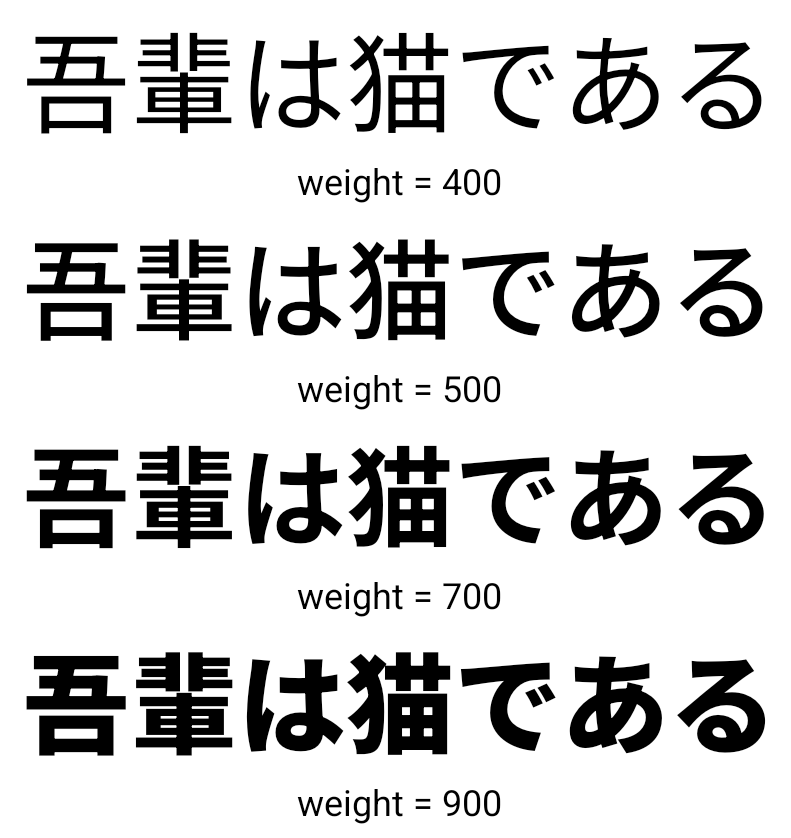
Giustificazione tra caratteri
A partire da Android 15, il testo può essere giustificato utilizzando la spaziatura tra le lettere
utilizzando JUSTIFICATION_MODE_INTER_CHARACTER. La giustificazione tra parole era
introdotto per la prima volta in Android 8.0 (livello API 26) e
giustificazione offre funzionalità simili per i linguaggi che utilizzano
spazio vuoto per la segmentazione, ad esempio cinese, giapponese e altri.

JUSTIFICATION_MODE_NONE.
JUSTIFICATION_MODE_NONE.
JUSTIFICATION_MODE_INTER_WORD.
JUSTIFICATION_MODE_INTER_WORD.
JUSTIFICATION_MODE_INTER_CHARACTER.
JUSTIFICATION_MODE_INTER_CHARACTER.Configurazione dell'interruzione di riga automatica
Android started supporting phrase-based line breaks for Japanese and Korean in
Android 13 (API level 33). However, while phrase-based line breaks improve the
readability of short lines of text, they don't work well for long lines of text.
In Android 15, apps can apply phrase-based line breaks only for short lines
of text, using the LINE_BREAK_WORD_STYLE_AUTO
option. This option selects the best word style option for the text.
For short lines of text, phrase-based line breaks are used, functioning the same
as LINE_BREAK_WORD_STYLE_PHRASE, as shown in the
following image:
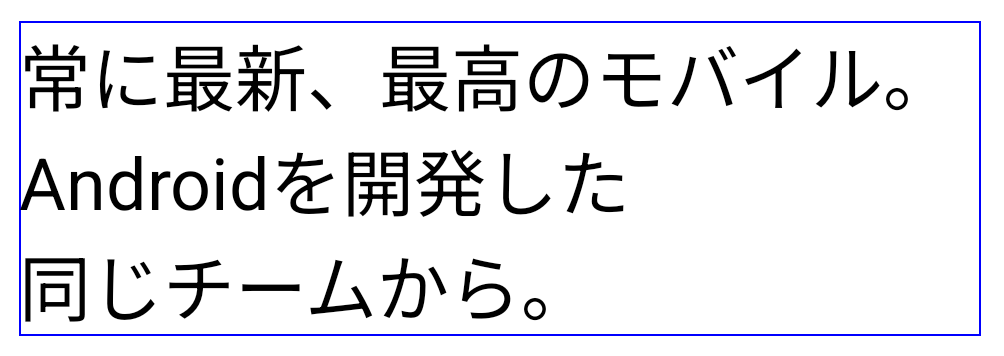
LINE_BREAK_WORD_STYLE_AUTO
applies phrase-based line breaks to improve the readability of the text.
This is the same as applying
LINE_BREAK_WORD_STYLE_PHRASE.For longer lines of text, LINE_BREAK_WORD_STYLE_AUTO uses a no
line-break word style, functioning the same as
LINE_BREAK_WORD_STYLE_NONE, as shown in the
following image:
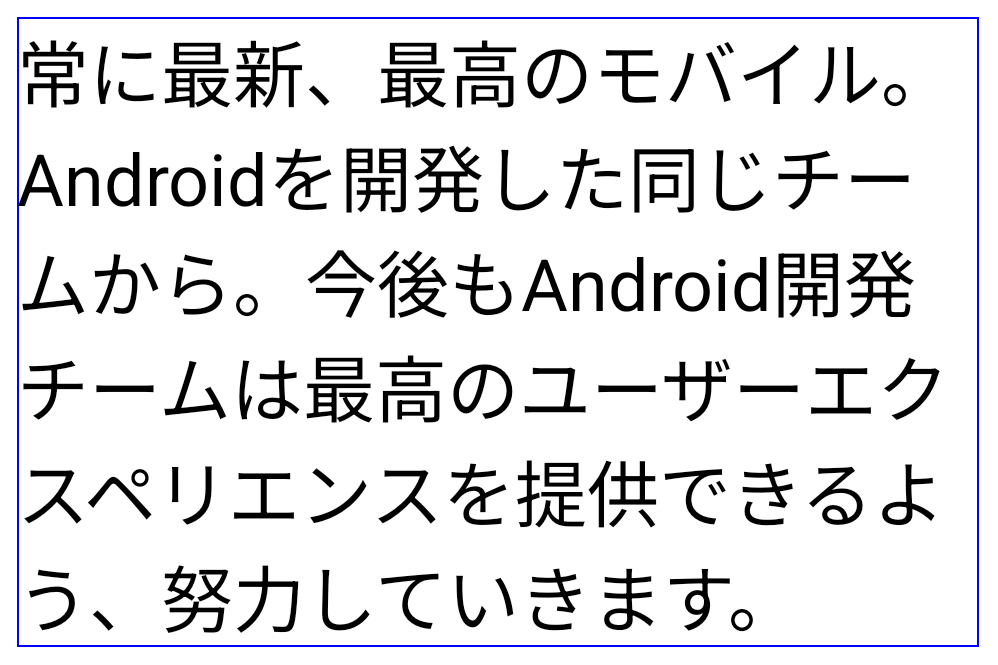
LINE_BREAK_WORD_STYLE_AUTO
applies no line-break word style to improve the readability of the text.
This is the same as applying
LINE_BREAK_WORD_STYLE_NONE.Carattere Hentaigana giapponese aggiuntivo
In Android 15, a font file for old Japanese Hiragana (known as Hentaigana) is bundled by default. The unique shapes of Hentaigana characters can add a distinctive flair to artwork or design while also helping to preserve accurate transmission and understanding of ancient Japanese documents.
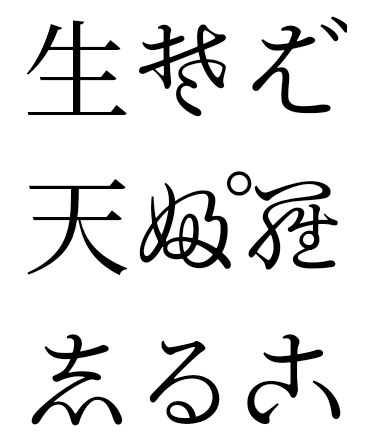
VideoLAN cone Copyright (c) 1996-2010 VideoLAN. This logo or a modified version may be used or modified by anyone to refer to the VideoLAN project or any product developed by the VideoLAN team, but does not indicate endorsement by the project.
Vulkan and the Vulkan logo are registered trademarks of the Khronos Group Inc.
OpenGL is a registered trademark and the OpenGL ES logo is a trademark of Hewlett Packard Enterprise used by permission by Khronos.

